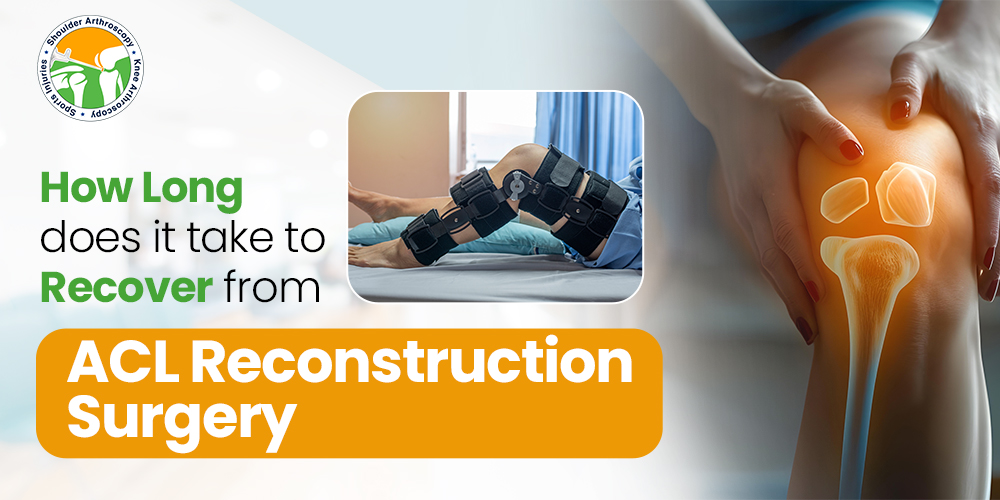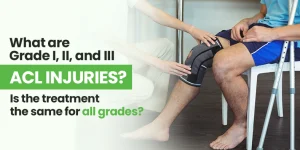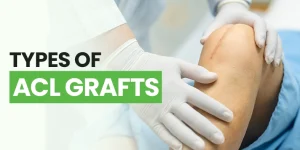The anterior cruciate ligament (ACL) is a crucial stabilizer in your knee joint. A torn ACL can significantly impact your mobility and activity level. ACL reconstruction surgery is one of most common surgeries required to restore knee stability.
But for many, the big question looms: how long does it take to recover from ACL reconstruction surgery? If you need to undergo an ACL reconstruction surgery and have been looking for answers related to the recovery process, Dr Siddharth Aggarwal has all the relevant information for you to go through.
This article delves deep into the recovery process, providing a detailed timeline and addressing frequently asked questions.
What is ACL Reconstruction Surgery?
ACL reconstruction surgery is done by replacing the torn ligament with a graft, typically tissue from another part of your knee like hamstring, patellar tendon or quadriceps tendon.
While the surgery itself takes a few minutes, the true journey lies in the recovery phase, which, depending on various factors, can take anywhere from 6 months to 9 months for a full return to function.
However, one of the most vital aspects is the ACL surgery recovery time. We will pay close attention to the week-by-week breakdown of the recovery process, highlighting all the expectations you should keep when it comes to the surgery.
We will also discuss insights about pain, physical therapy, and returning to sports after undergoing ACL reconstruction surgery.
How are ACL Tears Treated?
One of the most common misconceptions about ACL tears is that every tear requires surgical intervention. To be fair, that’s not usually the case.
For some individuals, especially those leading less active lifestyles, physical therapy alone may be sufficient to regain stability and function. However, for those seeking a total return to strenuous activities or experiencing significant instability, ACL reconstruction surgery is often recommended.
What kind of treatment route would be more suited for your condition depends on the initial consultation you undergo. During this consultation with leading specialists like Dr. Siddharth Aggarwal, you will discuss the symptoms and complications and then implement relevant treatment to overcome the issues.
The following are the primary treatment options:
Non-surgical treatments
This involves physical therapy (Physiotherapy) and Exercises to strengthen surrounding muscles, improve knee stability, balance/proprioceptive training and restore proper movement patterns. It may also include bracing for support. Usually, non-surgical routes are advised for patients experiencing partial ACL tears who should recover without going under the knife.
Surgical treatment, aka ACL reconstruction surgery
During surgery, the torn ACL is replaced with a graft. This graft is typically harvested from your hamstring tendon or another part of your knee. The graft is then secured to the legbone and thighbone using sutures or screws, creating a new, stable ACL.
Besides the actual surgery, it’s vital to pay attention to the recovery post-surgery. This contributes to the patient’s stability and chance at getting back to their old life.
What to Expect During ACL Reconstruction Surgery Recovery (Week-by-Week)?
From the start of this service page, we have been discussing and highlighting the importance of ACL reconstruction surgery.
However, if you are undergoing an ACL injury surgery, specialists like Dr. Siddharth Aggarwal will thoroughly discuss and highlight the dos and don’ts regarding healing and recovery after the surgery.
Here’s a breakdown for a better understanding:
Weeks 1-2
The first two weeks after surgery are the most vital period. You must listen to your surgeon’s advice and ensure that you aren’t overexerting yourself.
Focus: Pain Management, Swelling reduction, Regaining movement and Quadriceps Activation.
Activities: Limited / Full weight bearing using a walker or a brace.
Physical therapy: To ensure eventual flexibility in walking, you’d have to do a gentle range of motion exercises and QUADRICEPS strengthening exercises under the guidance of a professional physical therapist during the first two weeks.
Pain: You will have some pain, swelling, and discomfort during the first two weeks after the surgery.
MILESTONES: Walking independently without support
Range of Motion till 90 degrees
Good Quadriceps contraction with no extensor lag
Weeks 3-6
These are the weeks when your pain will gradually subside, and you will become more independent regarding the range of motions.
Focus: Increase the weight bearing gradually and prioritize strengthening exercises for the muscles involved.
Activities: By this time, you should be able to ditch the walker and start walking independently without support.
Physical therapy: You will also have to do muscle strengthening exercises, balance exercises, and gait training.
Pain: The pain and swelling will eventually subside by the sixth week, making life and recovery much more comfortable. Even the ACL injury symptoms will subside by this time.
Weeks 6-12
By the second or third month after your ACL reconstruction surgery, you will be strong enough to add more advanced exercises and have a more confident and stronger way of resuming regular physical activities.
Focus: Consistently working on improving the strength of the muscles and the body’s perception of the joint position.
Activities: You will be able to resume some low-impact exercises, including swimming and stationary cycling, under the guidance of a physical therapist.
Physical therapy: By this time, you should be able to include a variety of advanced muscle-strengthening exercises, such as plyometric (jumping and hopping exercises) and agility drills.
Pain: Pain should be non-existent to a minimum by this period. You might experience occasional stiffness in the muscles.
Months 3-6
You are now three months post-surgery and its time to return to a lot of the common lifestyle activities that you have to say goodbye to due to the ACL injury symptoms.
Focus: Resuming low-impact exercises and activities and improving muscle strength and stability.
Activities: While you can return to low-impact activities, high-impact activities that involve excess physical strain, like running and jumping, are still dangerous.
Physical therapy: You will be advised to continue your standard route of ongoing physical therapy involving all the standard exercises and activities as suggested under the rehabilitation program.
Pain: Occasional pain, discomfort, and stiffness might recur during this period, but it is common.
Months 9-12+
Even when you have returned to your sports activities and include some high-impact activities, prioritizing caution is mandatory to minimize re-injury risk and optimize long-term outcomes.
Focus: When you are one year post-op, you should focus on maintaining strength and flexibility and preventing future injury.
Activities: You will be able to resume all your standard activities, including extensive sports. However, as we have been reiterating, caution is key.
Physical therapy: During this recovery period, you will be under a maintenance program with exercises focusing on ongoing strength and agility.
Pain: If you have followed all the standard post-surgical recommendations for the ACL surgery recovery time, chances are you wouldn’t have to worry about the pain and discomfort by this period.
Having a comprehensive rundown of the surgery and its eventual recovery allows patients to undergo the procedure without fear. This is one of the main reasons why Dr Siddharth Aggarwal prioritizes patient education right from the initial consultation.
FAQs
Can a partial ACL tear heal without surgery?
In some cases, depending on the severity of the tear and your activity level, a partial ACL tear may heal with physical therapy alone. We’d 100% recommend scheduling a consultation with a specialist like Dr. Siddharth Aggarwal to analyze the best treatment route.
What should you do immediately after an ACL tear?
The RICE principle (Rest, Ice, Compression, Elevation) is crucial. Rest the injured knee, apply ice packs for 20-minute intervals several times a day, compress the area with a bandage, and elevate the leg above your heart. Early diagnosis and consultation with a doctor are essential for a proper treatment plan.
Is ACL reconstruction surgery painful?
Experiencing pain and discomfort after the ACL injury surgery is a common aftermath. However, you will be given proper pain management to minimize the pain and aid in the recovery process after the surgery.
How long have you been out of sports after ACL reconstruction surgery?
The timeline for returning to sports after ACL surgery varies for every patient and is influenced by factors such as the type of graft used, the extent of the injury, and the success of postoperative rehabilitation. You will be given a thorough timeline citing the dos and don’ts after the surgery, so we’d recommend you consider that.




